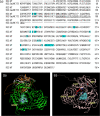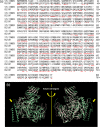Novel Soybean Variety Lacking Raffinose Synthase 2 Activity
- PMID: 38250426
- PMCID: PMC10795051
- DOI: 10.1021/acsomega.3c04585
Novel Soybean Variety Lacking Raffinose Synthase 2 Activity
Abstract
Variation in the raffinose family oligosaccharide (RFO) content in soybean is advantageous for livestock farming and health science. In this study, a soybean variety (GmJMC172) with a significantly low stachyose content in its seeds was identified in the NARO Genebank core collection. The results of the single-nucleotide polymorphism (SNP) analysis suggested that this phenomenon was related to a single-base deletion, inducing a frameshift mutation in raffinose synthase 2 (RS2), rather than the polymorphisms in the RS3, RS4, and stachyose synthase (STS) sequences. Differences in the enzymatic properties between the native RS2 and truncated RS2 were examined by using a three-dimensional model predicted using Alphafold2. In addition to revealing the missing active pocket in truncated RS2, the modeled structure explained the catalytic role of W331* and suggested a sufficient space to bind both sucrose and raffinose in the ligand-binding pocket. The soybean line, with seeds available from the NARO Genebank, could serve as breeding materials for manipulating the RFO content.
© 2024 The Authors. Published by American Chemical Society.
Conflict of interest statement
The authors declare no competing financial interest.
Figures







References
-
- Frankel O. H.Genetic perspectives of germplasm conservation. In Genetic manipulation: impact on man and society; Arber W. K., Limensee K., Peacock W. J., Stralinger P., Eds.; Cambridge University Press: Cambridge, England, 1984; pp 161–170.
-
- Funatsuki H.; Suzuki M.; Hirose A.; Inaba H.; Yamada T.; Hajika M.; Komatsu K.; Katayama T.; Sayama T.; Ishimoto M.; Fujino K. Molecular basis of a shattering resistance boosting global dissemination of soybean. Proc. Natl. Acad. Sci. U.S.A. 2014, 111, 17797–17802. 10.1073/pnas.1417282111. - DOI - PMC - PubMed
LinkOut - more resources
Full Text Sources
